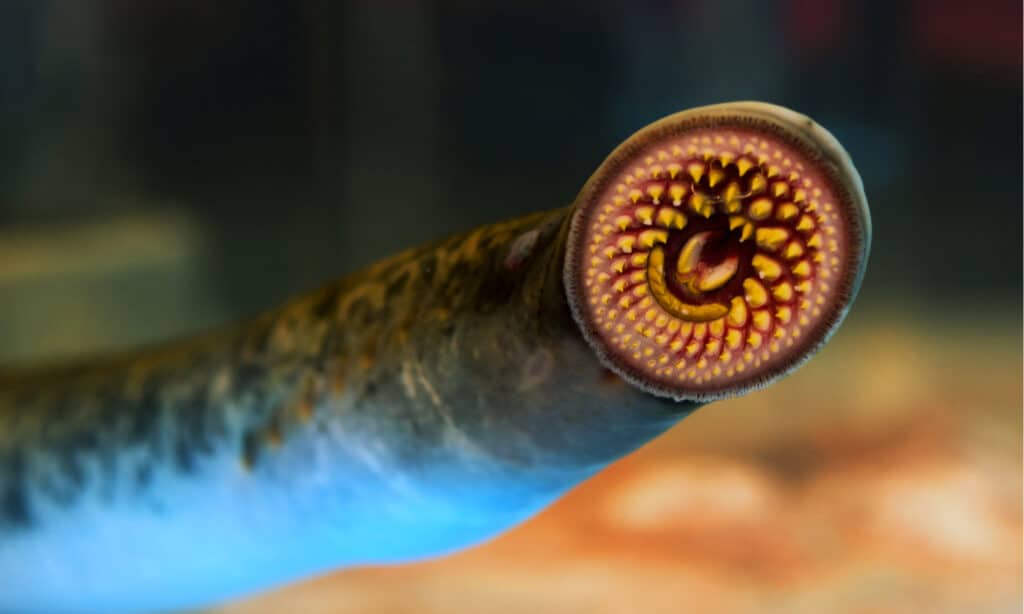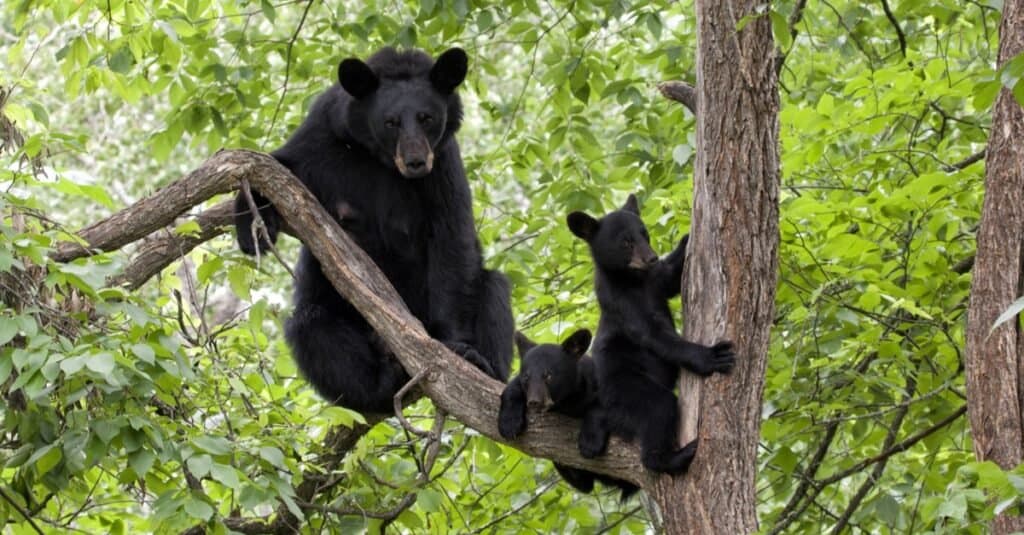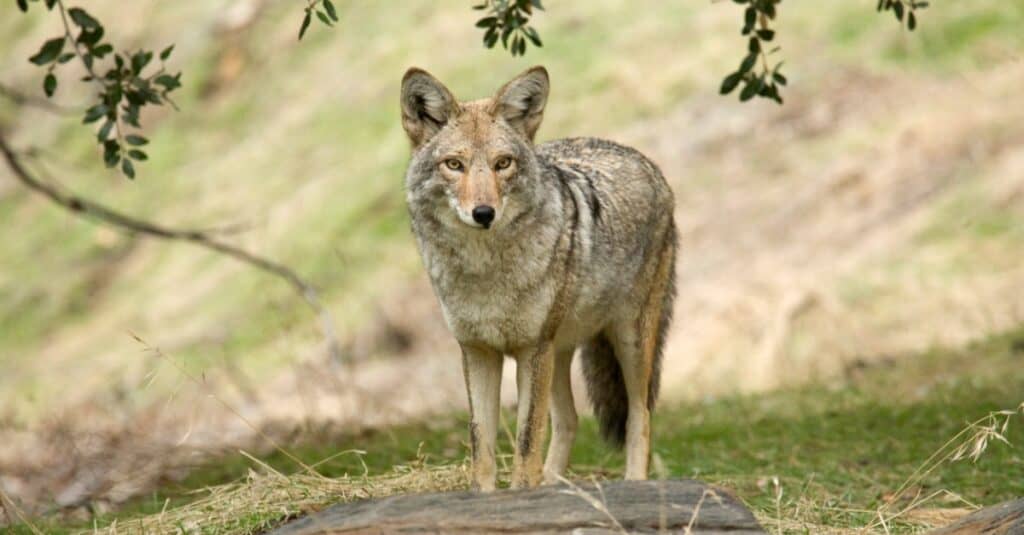What are the most dangerous animals in the Badger State of Wisconsin? Badgers are tough, but are they dangerous to humans? Bordering two Great Lakes, what dangerous animals might be in Lake Michigan or Lake Superior? Are there bears in the northern forests of the state? What about coyotes? Are there any venomous snakes? Let’s find out about the most dangerous animals in Wisconsin.
Are Badgers The Most Dangerous Animals In Wisconsin?

American badgers are 10-25 lbs and have sharp claws for digging burrows.
©Steve Boice/Shutterstock.com
Badgers have a reputation for being tough and tenacious. They have long, sharp canine teeth on the upper and lower jaw and long claws used for digging burrows. If they were 400 lbs, they might be a threat to humans, but badgers are only 10-25 lbs. They did not make the Wisconsin Department of Natural Resources “Common Nuisance and Urban Species.” Badgers are located throughout the state and make their homes in burrows in plains and prairies. One reason badgers are thought to be so mean is that if they are threatened, they are very vocal and will growl, snarl, hiss, and show their sharp teeth. They can also release a foul smell similar to skunks!
Badgers are not the friendliest animals but also not the most dangerous animals in Wisconsin.
What Dangerous Animals Are In The Great Lakes?

Sea lamprey have a suction-cup mouth filled with tiny sharp teeth. They attach to fish to suck their fluids but rarely attach to humans.
©Gena Melendrez/Shutterstock.com
- Sea Lamprey: These are the scariest-looking animals in Wisconsin! Sea lamprey are long and skinny, like eels, but have a circular suction cup mouth filled with tiny sharp teeth. They can be up to 2 feet long and are covered in slimy scaleless skin. They are parasitic and use their powerful suction mouth to clamp on to fish and suck. Once a fish has been attacked by a sea lamprey, it has a 40-60% mortality rate. That is why these lamprey are invasive fish in the Great Lakes. Do they attack humans? No, they do not attack humans, and they are small enough that if one did suction onto you, you would have time to immediately remove it before it starts using its row of teeth to gnaw through your skin.
- Snakehead: Snakeheads can “walk” on their pectoral fins! You can watch videos of these amazing walking fish that can actually survive out of water for 4 days, as long as they stay wet. They walk between lakes or other bodies of water. These snakeheads too are considered an invasive species in the Great Lakes and if you find one you need to report it to the DNR. While these fish are not dangerous to humans, they are dangerous to other fish and the ecosystem that the Great Lakes maintain.
- Lake Sturgeon: Sturgeon are the biggest fish you can catch in Lake Michigan. Some can be up to 7 feet long and weigh up to 200 lbs. They are long thin fish that do not have scales but an armored covering. These certainly are giant fish, but they are not dangerous because they do not have teeth. Instead, they troll the bottom of lakes and suck up food, swallowing it whole. The largest lake sturgeon on record was caught in Lake Michigan, was 8 feet long, and weighed 300 lbs, about the same as a baby elephant.
Are There Bears In Wisconsin?

There are about 24,000 black bears in Wisconsin.
©Debbie Steinhausser/Shutterstock.com
A large black bear population can be found in Wisconsin. There are 24,000 of them, to be exact (or close). Most of the bear populations are in the forested areas in the northern part of the state. Black bears are not as big as grizzlies and not as aggressive, but they can be dangerous. Every year in the United States, there are reports of bear attacks. Some of these attacks are provoked, but others are unprovoked. Black bears can be up to 400 lbs and have large sharp claws and teeth. They typically stay away from humans, but they may venture into residential areas in search of food if food is scarce.
Has There Ever Been A Bear Attack In Wisconsin?
According to the Wisconsin DNR, there have only been four people injured by bears since 2013, and no one has been killed. In October 2021, a man was in a deer stand during a hunting trip. He saw a bear wander under his stand, and within seconds, the bear had climbed the tree and bit the man in the back. He tried to remain calm, swung around, and started yelling at the bear. The bear backed down the tree but remained under the deer stand for half an hour. The man, Dalton Roach, a pitcher for the Springfield Cardinals, had puncture wounds to his back but was treated and released from the hospital. That is a crazy bear story, and it goes to show that black bears are one of the most dangerous animals in Wisconsin.
Are There Coyotes In Wisconsin?

Coyotes rarely attack humans, but they attack small pets.
©iStock.com/Fabiomichelecapelli
There are coyotes throughout Wisconsin. Although they are fearsome, they are only about the size of a small Labrador retriever. Coyotes come into residential areas if food is scarce. While they rarely attack humans, they can mistake small pets for rabbits and attack them. Keeping an eye on pets when coyote sightings have been reported is the best course of action. Also, keep all food inside, do not leave pet food out, and keep garbage sealed.
Are There Any Venomous Snakes In Wisconsin?

Timber rattlesnakes have a vertical pupil and triangle head. Their rattle is used as a warning to keep threats away.
©Scott Delony/Shutterstock.com
- Eastern Massasauga Rattlesnake: Found in Southwest Wisconsin, this snake is very rare, considered endangered in the state, has tan with with dark brown splotches, and can be up to 30 inches long.
- Timber Rattlesnake: Found in Southwest Wisconsin, this snake has two colorations; one black with faint markings and one tan with dark splotches. It is a large snake that can reach 6 feet.
Both rattlesnakes in Wisconsin are venomous and can bite, but bites are rare. These snakes prefer to keep away from humans and will rattle their tails as a warning before striking. Most people that are bit by these snakes are trying to pick them up or move them. Suppose you see these snakes, back away slowly, and do not try to pick them up. If you get bitten, you need to seek immediate medical attention. Medical facilities in the United States have antivenom available, which can help with the symptoms. Snake bites in the United States are rarely fatal. Rattlesnakes are dangerous animals in Wisconsin.
Summary Of The Most Dangerous (Deadliest!) Animals In Wisconsin
| Rank | Dangerous Animal |
|---|---|
| 1 | Sea Lamprey (invasive species) |
| 2 | Snakehead (invasive species) |
| 3 | Bears |
| 4 | Coyotes |
| 5 | Eastern Massasauga Rattlesnake |
| 6 | Timber Rattlesnake |
The photo featured at the top of this post is © U.S. Fish and Wildlife Service, Public domain, via Wikimedia Commons – License / Original
Thank you for reading! Have some feedback for us? Contact the AZ Animals editorial team.







